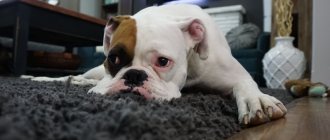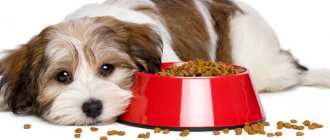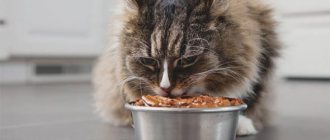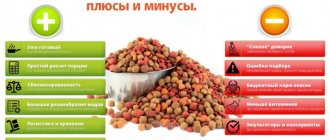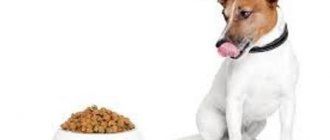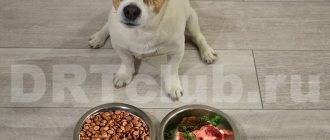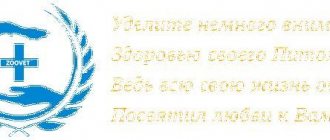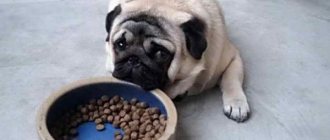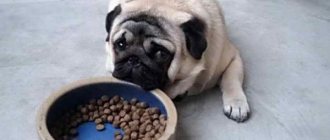04/05/2021 9 214 Dog nutrition
Author: Olga
Not only people go on diets, sometimes dogs also need an individual diet. And this is not always associated with excess weight, as is commonly thought; the pet may not gain the required weight. Oddly enough, gaining weight is more difficult than losing it. Especially if your pet for some reason refuses to eat the dry food prescribed by the doctor, and instead has a strange passion for cat food. Therefore, the question of what to feed a dog so that it gains the desired weight and why the pet stops eating with appetite is relevant for many owners!
[Hide]
How should you feed your pet to make it gain weight?
The problem of not gaining the required weight is very often associated with health problems. If your dog was quite well-fed, but suddenly began to lose weight and stopped eating with appetite, this is a very alarming bell. Increasing the dose of food for him is not a solution to the problem. In general, selecting an individual diet is a complex and painstaking process. If you do this thoughtlessly, you can disrupt the animal’s metabolism and get problems for the rest of its life.
Therefore, before fattening your dog, examine it; the most common causes of sudden weight loss are:
- Endoparasites. Very often, banal worms lead to thinness in dogs. It is imperative to combat parasites. In addition to thinness, worms are dangerous due to intoxication of the body and even death.
- Diabetes, hepatitis, kidney failure, cancer are serious diseases that lead to weight loss. But, in addition to weight loss, these ailments have many associated symptoms.
Some dog breeds always look thinner, in particular hounds and pointers. As well as young animals, weight gain is more intense after 2-3 years of age. Therefore, there is no need for unnecessary panic. But if you can examine the dog's ribs with the naked eye, and its spine and cheekbones protrude strongly, it is most likely underweight.
The following products help you gain the required weight:
- Specialized high-energy food. Pay attention to the energy content of the food your dog eats and choose the most nutritious options that are higher in protein and protein.
- If you feed natural food, then give preference to cereals such as buckwheat, rice, and oatmeal. The diet should contain complex carbohydrates; they take longer to break down and carry a greater energy charge. For meat, it is advisable to eat whole beef, chicken, and rabbit. High-quality meat contributes to the rapid gain of muscle mass. Do not feed too fatty foods; weight gain should occur due to an increase in muscle mass, and not due to the accumulation of fat masses.
- Mix unrefined vegetable oil into your food, about 1 tablespoon per serving. You can give chicken eggs and a few drops of fish oil 2-3 times a week.
- For variety and for proper weight gain, it wouldn’t hurt to eat fish, liver, cottage cheese, 2-3 times a week.
Three levels of dog fatness
Do not try to feed the animal with food and natural food at the same time. This scheme does not lead to weight gain, but threatens metabolic disorders. Another tip for owners who want their pet to gain weight: feed food three times a day instead of two. In this case, the dose of food may be the same or greater, insignificantly. In addition, when your pet is on an intensive diet, do not forget to monitor his weight and calculate the nutritional value of his meals.
Keep in mind that pets of different breeds should receive a certain amount of calories per day:
- Miniature breed dogs need approximately 110 kcal per 1 kg of weight;
- small dogs have 85 kcal per unit of weight;
- medium breeds for the same weight need 70 Kcal, and large breeds – 65 Kcal;
- For very large or giant breeds, 1 kg of mass requires 65 Kcal.
Symptoms and signs of underweight
But it’s not enough to know why your dog isn’t gaining weight. It is equally important to be able to determine that it weighs less than it should.
In fact, the task is much easier to cope with than it might seem. Often one glance is enough to give the dog the correct diagnosis. Experts usually distinguish two phases of low body weight: underweight and dystrophy.
The first is associated with a sharp transition to the waist. The lumbar vertebrae, like the pelvic bones, are noticeable, but do not protrude too much. By palpating the ribs, you cannot feel healthy subcutaneous fat.
Dystrophy is an even more advanced stage. In this case, not only is there no fat reserve, but also muscle mass is lost. The bones protrude so much that the dog turns into a skeleton covered with skin, and often shabby.
In any case, it is necessary to take measures as quickly as possible to save the animal.
The dog went through a terrible ordeal
What to do if your dog refuses dry food?
The now popular dry food is an ideal feeding option for both the dog and its owner. Feeding dog food takes minimal time. At the same time, a high-quality option is completely balanced and allows you to lose or gain weight as needed. Dogs often eat dry food with pleasure, but there are exceptions.
A dog may refuse dry food for the following reasons:
- She is used to natural food and dry food is new to her. If you want to switch your animal to a dry diet, do it gradually. Start replacing a small portion of your diet with dry food, gradually increasing it until it reaches 100%. This will take at least 1-2 weeks; a faster transition is fraught with food stress.
- The food is not suitable for the dog. There are a lot of manufacturers of dry diets and some option may simply not be suitable for your pet. Offer your dog several different foods and settle on the one that the animal will eat with great pleasure.
- Individual non-perception of feed components. This situation is quite unlikely; most foods are universal and hypoallergenic. Moreover, paradoxically, a dog can eat cheap food with greater appetite than more expensive food. This is due to the fact that economy food manufacturers use flavorings to make their product more attractive. While holistic or super-premium food uses only natural ingredients. And they don’t emphasize their taste with additional additives.
Dry food is often prescribed by veterinarians for medicinal purposes, and if your pet refuses to eat it, try this:
Soak dry food in water, low-fat kefir or yogurt. Perhaps your pet will like this option more.
Sometimes pets refuse food due to health problems. Consult your veterinarian to see if your pet may have dental or oral problems or indigestion. A video from the channel “Me and My Tail” will help you learn more about different foods.
Adding calories
Providing a balanced diet for your dog is always beneficial. This will help an undernourished dog eat better and will promote the recovery of a dog suffering from illness or disease. However, if your dog is already eating a balanced diet and just needs to gain weight, the answer is simple - he needs more calories.
If you're wondering "what can I feed my dog to gain weight", there are two main options and it's quite easy to do, depending on your dog's personality.
Give them new food every day
Sometimes the answer is as simple as offering them more food. If the food is already balanced, with plenty of protein, carbohydrates, minerals and vitamins, then more of it will help your dog gain weight - simple! So, if your dog already eats breakfast and dinner, start adding lunch at noon.
However, it is important to note that if you use this method, your dog will also need more toilet breaks. So, if you want to avoid an unpleasant surprise, be sure to add another trip outside to your routine.
© shutterstock
Offer them human food
Many human foods are dangerous for dogs, so don't give your dog human food unless you are at all sure whether it will be good for them. However, if you are confident, feeding your dog extra treats of human food, such as when you are eating lunch, will create an additional opportunity for your dog to add a few calories to his day and help him gain weight.
Is it acceptable to feed a dog cat food?
Pet food manufacturers differentiate between dog and cat food for a reason. These pets have different needs and all this is taken into account in the qualitative and quantitative composition of their food. Therefore, it is wrong to feed a dog with cat food, as well as a cat with dog food.
For example, cat food contains more proteins. And a dog, if it regularly eats such food, has every chance of quickly getting a metabolic disorder. And also serious problems with the digestive tract, kidney failure and skin rashes.
In addition, cats have a need for the amino acid taurine, which is reflected in the composition of cat food. Dogs are capable of generating this amino acid on their own, and an additional dose of taurine from the outside is detrimental to canine health.
And in general, dogs and cats need different ratios of proteins, fats and carbohydrates and different amounts of vitamins and amino acids. Therefore, systematically feeding a dog with cat food is unacceptable.
It’s another matter if the dog ate cat food just once – this is not a reason to panic. The difficulty can be observed if you have both a cat and a dog living at home at the same time. For some reason, animals often think that the food in their neighbor’s bowl tastes better. In addition, dogs can use their physical superiority and take food from cats. The solution is to feed each pet individually so that no one is tempted to eat their neighbor’s food.
Exercises
- Running load
Jogging or cycling allows you to train all muscle groups and activate the work of your internal organs.
- Swimming.
Experts consider swimming a universal exercise. The pet's conquest of the water element ensures the development of the back muscles. In addition, this activity will improve your mood.
- Walking up the stairs.
The development of the muscles of the hind legs plays an important role, as it improves coordination of movements. If your dog periodically climbs the stairs, this will help him strengthen his muscle corset.
- Jumping, overcoming barriers.
By overcoming barriers, the pet uses muscles that are not used in other exercises. Make sure that the obstacles are low. Choose a non-slip surface.
- Games with fellow tribesmen
Joint training with relatives allows you to combine business with pleasure. The pet becomes more active and becomes interested in doing the exercises. Veterinarians say that healthy competition creates in animals the desire to do everything 100%.
Video “What to feed a dog?”
The following video, taken from the “Expert Speaks” channel, should help you create the right diet.
Sorry, there are no surveys available at this time.
Was this article helpful?
Thank you for your opinion!
The article was useful. Please share the information with your friends.
Yes (100.00%)
No
X
Please write what is wrong and leave recommendations on the article
Cancel reply
Rate the benefit of the article: Rate the author ( 4 votes, average: 4.50 out of 5)
Discuss the article:
Visiting the veterinarian
Finally, remember that different dog breeds often have different ideal weights and body shapes. For example, a Greyhound will always look slimmer than a Labrador Retriever. However, the best thing you can do if you are concerned about your pet's weight is to take it to a veterinarian. They will give you the best advice regarding the breed and health of your dog. When visiting the veterinarian, it is recommended to bring :
- Record their weight loss if you weighed them regularly;
- The packaging of any meals and treats you give them, as well as how often you offer them that food;
- Record any potential additional symptoms;
- Recording how much they have eaten of the food you give them;
- Record their activities and exercises.
Author of the article : Olivia Williams .
Brief conclusions
Objectively assess your pet's condition. In the case when the ideal diet is chosen, the tests are clear and the animal feels cheerful, there is no need to panic right away. If other dog breeders consider your dog to be thin, this does not mean that the weight is falling. Carry out control weighing in the morning, find out the independent indicators and metrics of your breed. Change the food, combine dry food and natural food. And be sure to consult with professionals. Health to you and your four-legged friend!
